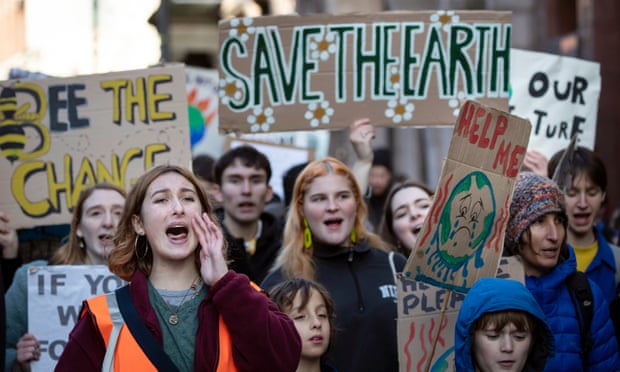We've had so many wins': why the green movement can overcome climate crisis.

Leaded petrol, acid rain, CFCs … the last 50 years of environmental action have shown how civil society can force governments and business to change.
Leaflets printed on “rather grotty” blue paper. That is how Janet Alty will always remember one of the most successful environment campaigns of modern times: the movement to ban lead in petrol.
There were the leaflets she wrote to warn parents at school gates of the dangers, leaflets to persuade voters and politicians, leaflets to drown out the industry voices saying – falsely – there was nothing to worry about.
In the late 1970s, the UK was still poisoning the air with the deadly toxin, despite clear scientific evidence that breathing in lead-tainted air from car exhausts had an effect on development and intelligence. Recently returned from several years in the US, Alty was appalled. Lead had been phased out in the US from 1975. Why was the British government still subjecting children to clear harm?
Robin Russell-Jones asked the same question. A junior doctor, he quickly grasped the nature of the lead problem, moving his family out of London. His fellow campaigner, Robert Stephens, amassed a trove of thousands of scientific papers, keeping them in his garage when his office burned down – he suspected foul play.
Their campaign took years. But in 1983, a damning verdict from the Royal Commission on Environmental Pollution prompted the UK government to decree that both petrol stations and manufacturers must offer lead-free alternatives. Leaded petrol was finally removed from the last petrol pumps in the UK in 1999.
Today, it seems incredible that lead was ever used as a performance improver in car engines. Clean alternatives were available by the 1970s, but making the transition incurred short-term costs, so the motor industry, led by chemicals companies, clung on, lobbying politicians and ridiculing activists.

Faced with multiplying, and interlinked, environmental crises in the 2020s – the climate emergency, the sixth extinction stalking the natural world, the plastic scourge in our oceans, the polluted air of teeming metropolises – it is easy to feel overwhelmed. Lockdown offered a tantalising glimpse of a cleaner world, but also revealed a starker truth: that the global economy is not set up to prioritise wellbeing, climate and nature. What can we do, in the face of these devastating odds?
It is easy to forget that environmentalism is arguably the most successful citizens’ mass movement there has been. Working sometimes globally, at other times staying intensely local, activists have transformed the modern world in ways we now take for granted. The ozone hole has shrunk. Whales, if not saved, at least enjoy a moratorium on hunting. Acid rain is no longer the scourge of forests and lakes. Rivers thick with pollution in the 1960s teem with fish. Who remembers that less than 30 years ago, nuclear tests were still taking place in the Pacific? Greenpeace’s Rainbow Warrior ship was blown up by the French government in 1985, with one death and many injuries, in a long-running protest.
As well as giving heart to activists now, these victories contain important lessons. “The environmental movement has been very successful,” says Joanna Watson, who has worked at Friends of the Earth for three decades. “We’ve had so many campaigns and wins. Sometimes it’s been hard to claim success, and sometimes it takes a long time. And sometimes things that worked before won’t work now. But there’s a lot we can learn.”
Lifeless lakes and leafless trees
Acid rain, first identified in the 1850s, took decades to address. The first murmurings of concern came about after the second world war and there were concerted efforts to solve it in the 1960s. But it is the campaign that Nat Keohane, vice-president at the Environmental Defense Fund and a former lecturer at Yale, points to when he wants to invoke the success of the global environmental movement. “The reason I talk about acid rain is that it’s one of the instances where we solved the problem.”
Acid rain occurs when sulphur dioxide and nitrogen oxides react with moist air to form weak acids, which then fall from clouds, killing plants and aquatic life. The scars can still be seen in parts of the US and northern Europe, where acid has etched limestone building facades, and faces have dissolved from statues. But in most of the world – except China, where the problem persists – the lifeless lakes and leafless trees that acid rain created have long since revived.

“Environmental groups led a drumbeat of campaigning on acid rain throughout the 1980s,” says Keohane.
Public pressure in the worst-offending countries – chiefly the US and the UK, which were responsible for acid rain that fell largely on neighbouring countries such as Canada and Scandinavia – was key. Watson recalls one telling advertising campaign: posters printed on litmus paper that said: “When acid rain is falling, you should see red” – offering a vivid illustration of the problem.
Getting businesses onside was a different matter. In the US, that was achieved through a novel mechanism that offered financial incentives from rivals, rather than the public purse. “It was the first successful demonstration of a market-based approach,” says Keohane. US power plant operators were issued with a limited number of allowances for how much sulphur and nitrogen oxides they could emit. They could buy and sell these among themselves, meaning the dirtiest companies had to buy them from those who cleaned up fastest, while the number of allowances available was gradually reduced. This cap-and-trade system operated successfully from 1990, becoming the model for a similar approach to greenhouse gases under the 1997 Kyoto protocol – though that attempt was less successful, because the US rejected it.
“The benefits were 40 times greater than the costs,” says Keohane. “There was an 86% reduction in pollutants, from 1990 to 2015, and there were huge unappreciated benefits beyond acid rain, on cleaning up particulates [an especially harmful form of air pollution].”
What acid rain showed is that businesses can be successfully regulated, without causing economic damage, says Keohane. As with the campaign against lead, companies resisted new rules for years, but when they came, they responded swiftly, showing governments they could afford to be less timid.
‘When we need to act, we can’
There are also lessons for today’s campaigners in the close shaves. Climate change threatens to melt the ice caps, raise sea levels, destroy agriculture over swaths of the world, and is already causing humanitarian disasters. Time is short. But a lesson from 40 years ago shows the world can move quickly and decisively if it has to.
About 15-35km above the surface of the Earth, the ozone layer acts as a filter against the sun’s radiation, blocking about 97% to 99% of medium-frequency ultraviolet light. That is important, because over-exposure to ultraviolet radiation is harmful to most living things, including plants and animals, and causes skin cancers, eye problems and genetic damage in humans.
In 1974 came the first indications that all was not well in the lower stratosphere. Research by Mario Molina, who died last week, and F Sherwood Rowland, both later awarded Nobel prizes, found that chemicals called chlorofluorocarbons (CFCs), commonly used as propellants in aerosols, were likely to be reacting with the ozone and depleting it.
The first moves against CFCs were in the US, Canada, Sweden and a few other countries in 1978, but others hung back, as chemical companies dismissed the fears as theoretical. Then, in 1985, the British Antarctic Survey published clear evidence of damage, in the form of a patch of drastically thinned ozone across the south pole. Their measurements showed 40% less ozone than had been detected 20 years earlier. The science was indisputable.
The world moved quickly. Governments got together under the aegis of the UN and forged the Montreal Protocol in 1987, which phased out ozone-depleting chemicals globally. “The Montreal protocol is the best environment treaty the world has ever created,” says Durwood Zaelke, the president of the Institute for Governance and Sustainable Development. “It solved the first great threat to the atmosphere, and put the ozone layer on the path to recovery by 2065. There’s very strong empirical evidence that it has done its job".

When the Montreal protocol was signed, the world was rapidly approaching a precipice. The further the ozone depleted, the less likely it was to regenerate naturally. If the damage continued beyond a certain point, recovery and natural repair would have become virtually impossible, even if production of the harmful chemicals ceased. “It would have been beyond repair in about five or 10 years if we had not acted,” says Paul Bledsoe, a strategic adviser at the Progressive Policy Institute thinktank in Washington DC.
The Montreal protocol shows, as the response to Covid-19 demonstrated, that the world can move quickly when governments want to.
“If a government needs to act, and Covid has shown this, my God can a government act,” says John Sauven, the executive director of Greenpeace UK. “All of a sudden, no regulation, no amount of money is a problem. When we need to act, we can.”
A key factor in the Montreal protocol and its preceding successes was making the economic case for action. When it came to ozone-depleting chemicals, the chemical companies found they could manufacture substitutes – and make more money doing so. Car companies made a similar calculation on lead in petrol, and US power plants had the incentives of cap-and-trade to halt acid rain. Today, a comparable economic shift has already happened in the field of climate action: renewable energy is cheaper in many countries than coal, gas and oil, and costs are likely to fall further.
But some companies with fossil fuels to sell will still be left stranded, and corporate vested interests have not gone away. Russell-Jones recalls that Associated Octel, the UK’s main lead producer, “went apoplectic” when he started touring radio studios in the early 1980s, sending an operative to trail him in a car, following him in to demand right of reply on the same programme he had just appeared on. These days, there is no need for such efforts as internet trolls can reach far more people.
“Fake news is everywhere,” he says. “Disinformation from rightwing thinktanks, on air pollution and climate change, is all over the internet. And the media landscape has shifted to the right.”
Transcending political divisions
One of the most striking aspects of successful environmental campaigns of the past is how they straddled the left-right political divide. Key green legislation and decisions, including the Montreal protocol and the 1992 UN framework convention on climate change, the parent treaty to the Paris agreement, were put forward and signed by leaders from across the political spectrum.
This may be partly because world leaders in the past were more willing to listen to scientists than today. “[The UK prime minister, Margaret] Thatcher got it, on the ozone layer – she was a chemist, she read all the scientific papers herself,” says Zaelke. “[Ronald] Reagan got it because he’d had skin cancer.”

But a changing political discourse in many countries, driven by a rightwing populism that has forsaken reality in favour of stoking imagined grievances, has created a harsher political environment, according to Bledsoe. “The opponents [of climate action] have learned that in a culture where people get their news from politically dominated outlets [and the internet], they can get away with lying about almost anything.” But he says there is one bright spot: “Younger people are rejecting these lies about climate change.”
In building a consensus that can transcend political divisions, Keohane believes green campaigners must focus on the outcome rather than the process and bring forward constructive ideas. “People get used to thinking about the fight, not the winning.” he says. “We have to remind ourselves that we have done it and we can do it again.”
Reaching out across divisions to foster a broad and inclusive sense of community is essential. Alty may have spent seemingly endless hours printing and handing out leaflets, but “I never felt lonely, not once,” she says, and the many positive responses from people she encountered kept her going. “It was very labour-intensive, it was like rolling a heavy boulder up a very steep hill. But there is a value in knowing you are doing a worthwhile thing.”
For Watson, the emphasis on what people have in common, despite surface divisions, is at the core of the green movement. “The thing about the environmental movement is, it crosses all barriers,” she says. “Whatever our political bent, we are all human, all people on the planet, and all interdependent. The environment is not something separate from us – we are all in the environment. It is where we live.”
12 October 2020
The Guardian




